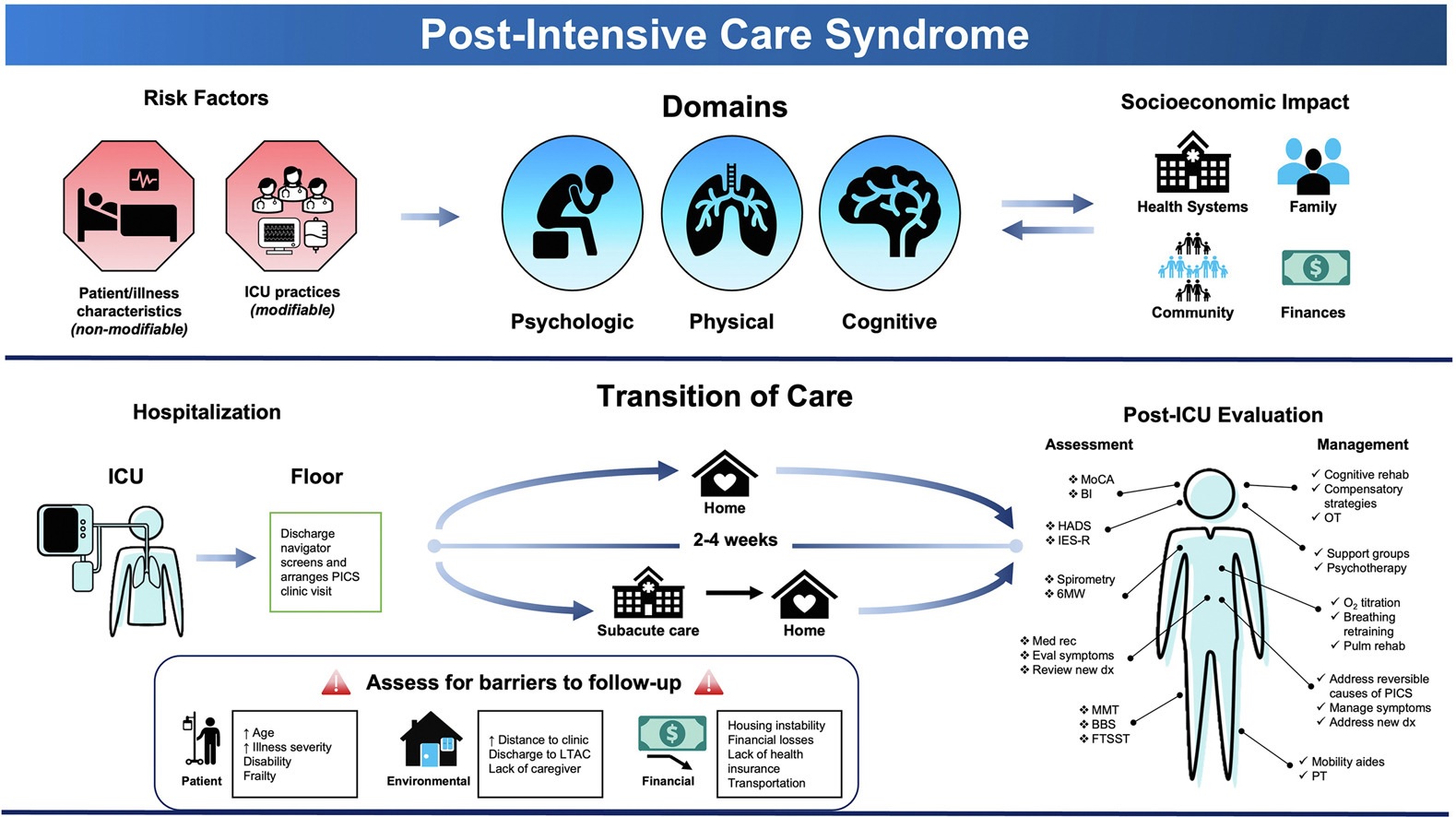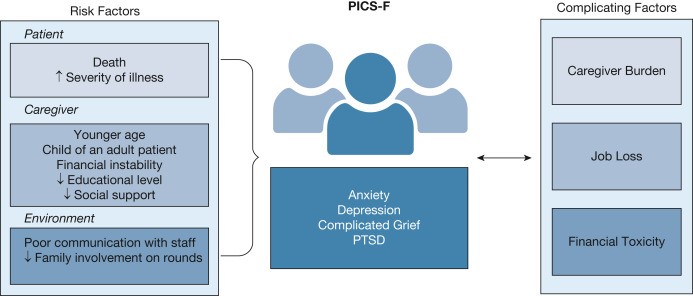Review of physical, psychological, and/or cognitive manifestations that occur after hospitalization for critical illness.
| emphasize |
|
1. he post intensive care syndrome (PICS) affects 80% of patients who survive ICU stay.
2. Intensivists should try to minimize common modifiable risk factors for the development of PICS. These include higher cumulative doses of sedative medications, immobility, delirium, sleep disturbance, and hyperglycemia.
3. The social and financial impact of PICS can be substantial; up to 50% of patients who survive ICU rely on home care support, and up to 40% of patients who survive ICU are unable to return to work one year after discharge.
|
|
clinical issues
A 56-year-old woman with a history of diabetes and obesity was admitted to the ICU with pneumonia. He was hospitalized with acute respiratory distress syndrome (ARDS), shock, acute renal failure, and central line-associated bacteremia. He required mechanical ventilation for 7 days, vasopressor medication for 5 days, and continuous renal replacement therapy for 4 days. She developed severe delirium and agitation during intubation, requiring deep sedation on multiple occasions. She also exhibited weakness and mobility issues and was admitted to a rehabilitation facility. He is currently undergoing post-ICU follow-up 1 month after discharge. His family reported he had memory problems. His score on the Montreal Cognitive Assessment was 14/30, equivalent to moderate cognitive impairment.
Which of the following conditions is most associated with the development of long-term cognitive impairment?
Answer: Shocked
B: Delirium
C: Acute renal failure
D.bacteremia
(See responses/reasons at the end of the article)
|

he post intensive care syndrome (PICS) has been recognized for over ten years and is defined as New deterioration or deterioration in physical, mental or cognitive health, or a combination thereof, following a major illness.
Up to 80% of patients who survive ICU experience PICS symptoms at discharge
he Purpose The purpose of this review is to describe the clinical manifestations of PICS and its impact on patients, families, and the healthcare system. The authors also discuss the relationship between PICS and social determinants of health and outline a framework for assessment and management.
| Clinical manifestations of PICS |
PICS may include impairments in cognition, mental health, physical functioning, or a combination of these following severe illness (Figure 1A).
> cognitive domain
Survivors of serious illness are vulnerable to cognitive dysfunction Regardless of pre-existing conditions, comorbidities and age.Cognitive deficits may be a combination of both persistentone-third of patients who survived ICU developed deficits 1 year after hospitalization, e.g. Seriousreflecting the extent of damage seen in moderate traumatic brain injury and Alzheimer’s dementia.
this clinical manifestations This may include declines in memory, executive function, mental processing speed, attention or concentration, all of which prevent people from engaging in the conscious, goal-directed behaviors necessary to perform activities of daily living and return to a normal life. their premorbid functional status.
exist. .between risk factors potentially modifiable, delirium It has been the most studied. Delirium duration was an independent predictor of long-term cognitive impairment, even after adjusting for age, education, preexisting cognitive function, disease severity, and sedative medication use.Figure 1B).
> psychological realm
Psychiatric illness following critical illness is common. Rates of anxiety, depression, and post-traumatic stress disorder (PTSD) were reported at 62%, 36%, and 39% respectively, with symptoms of these three conditions being highly coexisting.
Patients who survive ICU are also at increased risk Suicide and self-injurious behavior Compared to hospital survivors who never required ICU admission.
also, sleep disorder This condition is common after ICU hospitalization, occurring in up to 57% of patients within 6 months of discharge, and is often associated with ongoing psychological deterioration.
Risk factors for psychological sequelae include younger age, previous mental health diagnosis, and need for mechanical ventilation. Preexisting and hospitalization-related sleep disturbances are associated with an increased risk of post-illness sleep disturbances.Figure 1B).

figure 1 – Diagram showing clinical manifestations and risk factors of PICS (Post-Intensive Care Syndrome). arriveCommon sequelae of critical illness in patients who survive ICU. Second, risk factors associated with PICS, classified by degree of modifiability. LOS = length of stay; PICS = post-intensive care syndrome; PTSD = post-traumatic stress disorder.
> physical domain
Up to 80% of ICU survivors experience new experiences body dysfunction When discharged from hospital.Types of physical injuries vary and may include ICU acquired weakness (ICU-AW), impaired lung function and cachexia.
this ICU acquired weakness (ICU-AW) is defined as neuromuscular dysfunction without a reasonable cause other than critical illness and its treatment, usually as a result of critical myopathy, critical polyneuropathy, or a combination of both. It is present in nearly half of patients who survive an ICU stay and can manifest in a variety of ways, including poor mobility, weakness, contractures, and reduced exercise tolerance.
Among potentially modifiable risk factors, the use of neuromuscular blockers and corticosteroids has historically been associated with the development of critical illness myopathy, particularly when used in combination. However, the above data suggest that short-term use of these medications may be safe.
also, patient mobilization (e.g., progressive mobilization starting with range of motion and eventually progressing to ambulation) is a preventive measure known to reduce the risk of ICU-AW. Figure 1B).
> Disability, health care use, and mortality
The collective sequelae of critical illness can ultimately lead to frailty, disability, and reduced health-related quality of life (HRQoL).It is worth noting that vulnerability Forty percent of patients who survived the ICU 12 months after discharge had a new episode or worsening. Thus, one year after hospital discharge, 20% of previously independent individuals had at least partial disability detected, with low scores primarily attributable to reduced physical function.
Health care usage patterns may also change after a critical illness, increasing the risk of severe illness hospitalized again This can last for many years.More than half of patients are readmitted to the hospital after discharge, and survivors have increased outpatient visits, emergency room visits, and hospitalizations in the year after critical illness compared with the year before
at last, risk of death Even if patients survive critical illness, mortality remains high, with 1-year mortality rates as high as 21%. This risk is particularly significant for patients who have survived and been treated in the ICU. Mechanical Ventilationits annual mortality rate can exceed 40%.
> Post-Intensive Care Syndrome (PICS)
The impact of surviving an ICU may extend beyond the individual patient.
25% to 50% of ICU survival patients require long-term family support This may be similar to the burden of care for other chronic conditions.In turn, caregivers may experience new psychological symptoms, collectively known as post-intensive care syndrome at home. Prevalence varies widely, ranging from 6% to 69% in the first 6 months and continuing for several years. The most common disorders include anxiety (73%), depression (50%), complicated grief (52%) and post-traumatic stress disorder (PTSD). (56%).
These symptoms usually lessen over time, but may persist after 6 months in approximately one-third of people, and are associated with lower HRQOL and psychological distress for years thereafter. Risk factors for the development of PICS families can generally be divided into patient-, caregiver- and environment-related characteristics (figure 2).

figure 2 – Diagram showing risk factors, clinical manifestations and comorbidities of PICS families. PICS-F=Post Intensive Care Family Syndrome; PTSD=Post Traumatic Stress Disorder.
> financial toxicity
Patients who survive ICU may experience financial toxicity important. Less than half of survivors who previously worked in the ICU returned to work one year after serious illness, and about one-third were still unemployed after 5 years. As a result, job loss can lead to depleted savings, loss of health insurance coverage, and increased medical expenses.

